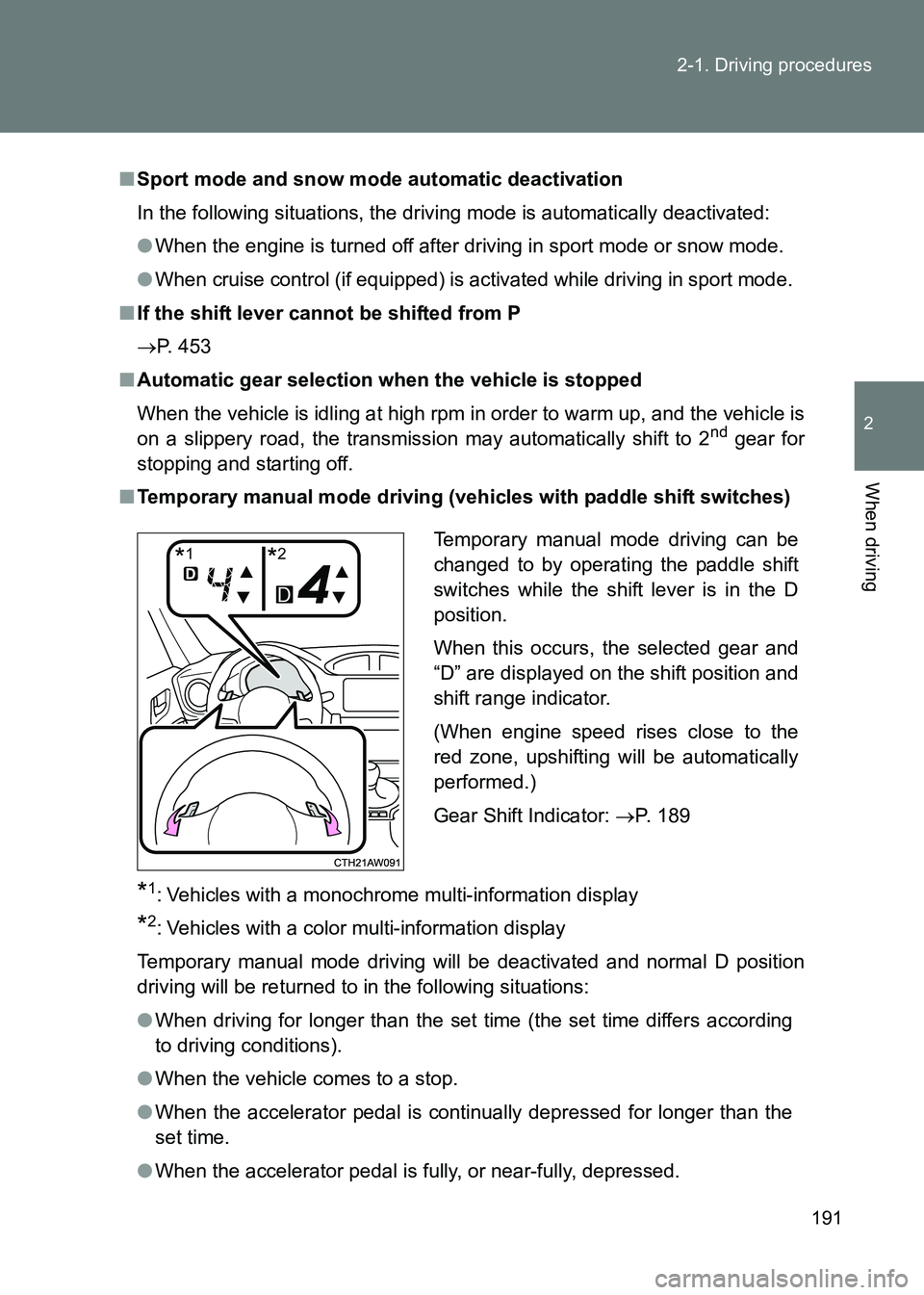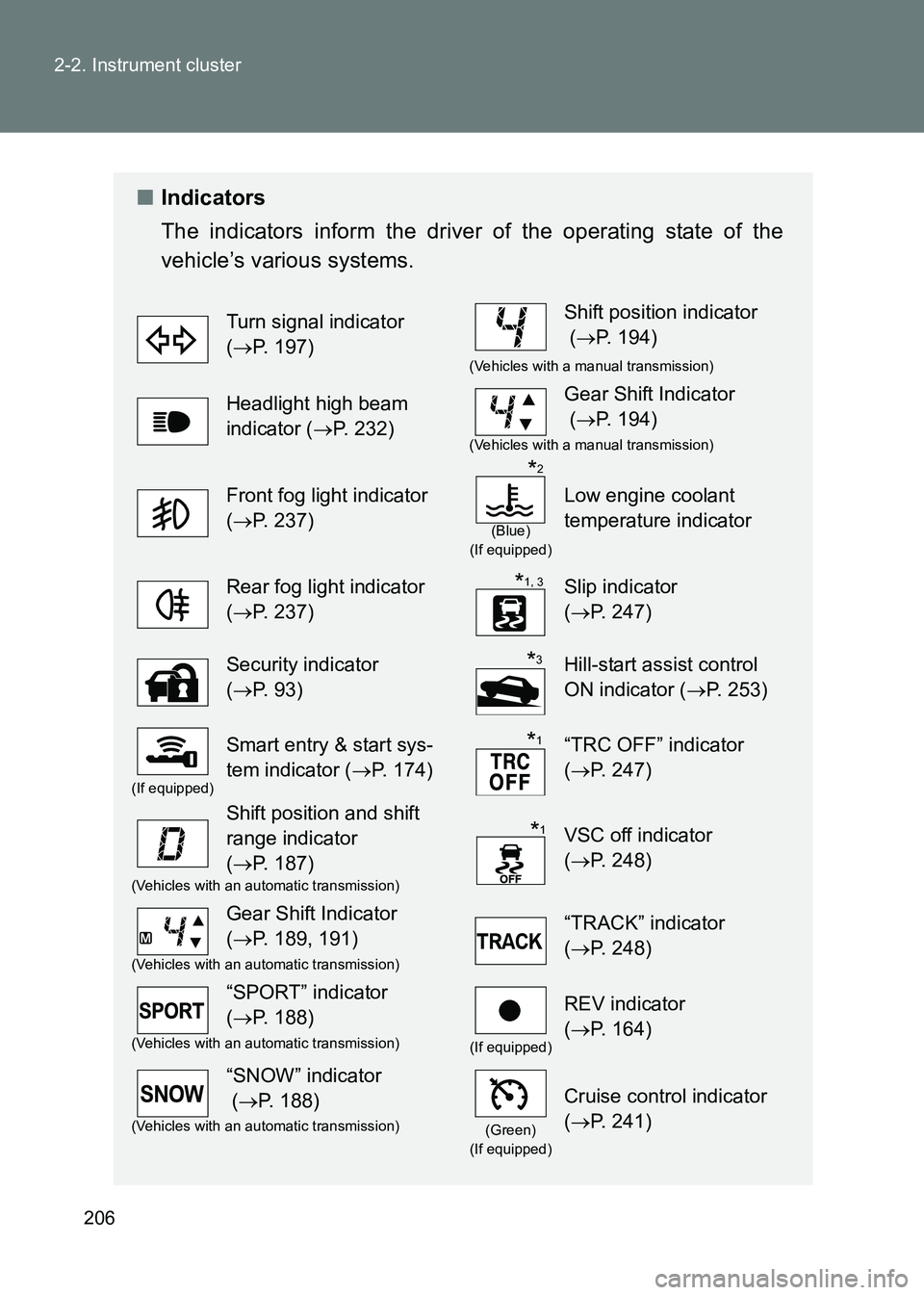Page 184 of 505

184
2-1. Driving procedures
86_EE (OM18071E)
■
Turning the key from “ACC” to “LOCK”
Shift the shift lever to N (manual transmission) or P (automatic
transmission). ( →P. 186, 193)
■ If the engine does not start
The engine immobilizer system may not have been deactivated. ( →P. 93)
Contact any authorized Toyota dealer or repairer, or another duly qualified
and equipped professional.
■ When the steering lock cannot be released
■ Key reminder function
A buzzer sounds if the driver’s door is opened while the engine switch is in
the “LOCK” or “ACC” position to remind you to remove the key.
■ Immediately after reconnecting the battery terminals due to replacing
the battery and so forth
The engine may not start. If this occurs, turn the engine switch to the “ON”
position, and start the engine after waiting at least 10 seconds. Idling may be
unstable immediately after the engine starts, however, this is not a malfunc-
tion.
STEP 1
Push in the key and turn to the “LOCK”
position.STEP 2
When starting the engine, the engine
switch may seem stuck in the “LOCK”
position. To free it, turn the key while turn-
ing the steering wheel slightly left and
right.
Page 186 of 505
186
2-1. Driving procedures
86_EE (OM18071E)
Automatic transmission∗
Select a shift position appropriate for the driving conditions.
■Shifting the shift lever
Vehicles without a smart entry & start system
While the engine switch is in the “ON” position, move the
shift lever with the brake pedal depressed.
When shifting the shift lever between P and D, make sure that the
vehicle is completely stopped.
Vehicles with a smart entry & start system
While the “ENGINE START STOP” switch is in IGNITION
ON mode, move the shift lever with the brake pedal
depressed.
When shifting the shift lever between P and D, make sure that the
vehicle is completely stopped.
∗: If equipped
Page 191 of 505

191
2-1. Driving procedures
2
When driving
86_EE (OM18071E)
■
Sport mode and snow mode automatic deactivation
In the following situations, the driving mode is automatically deactivated:
●When the engine is turned off after driving in sport mode or snow mode.
● When cruise control (if equipped) is ac tivated while driving in sport mode.
■ If the shift lever cannot be shifted from P
→ P. 453
■ Automatic gear selection when the vehicle is stopped
When the vehicle is idling at high rpm in order to warm up, and the vehicle is
on a slippery road, the transmission may automatically shift to 2
nd gear for
stopping and starting off.
■ Temporary manual mode driving (vehicles with paddle shift switches)
*1: Vehicles with a monochrome multi-information display
*2: Vehicles with a color multi-information display
Temporary manual mode driving will be deactivated and normal D position
driving will be returned to in the following situations:
● When driving for longer than the set time (the set time differs according
to driving conditions).
● When the vehicle comes to a stop.
● When the accelerator pedal is continually depressed for longer than the
set time.
● When the accelerator pedal is fully, or near-fully, depressed. Temporary manual mode driving can be
changed to by operating the paddle shift
switches while the shift lever is in the D
position.
When this occurs, the selected gear and
“D” are displayed on the shift position and
shift range indicator.
(When engine speed rises close to the
red zone, upshifting will be automatically
performed.)
Gear Shift Indicator:
→P. 189
*1*2
Page 193 of 505
193
2-1. Driving procedures
2
When driving
86_EE (OM18071E)
Manual Transmission∗
∗: If equipped
■Shifting the shift lever
Fully depress the clutch pedal before operating the shift lever, and
then release it slowly.
■ Shifting the shift lever to R
Shift the shift lever to R while
lifting up the ring section.
Page 196 of 505
196
2-1. Driving procedures
86_EE (OM18071E)
NOTICE
■
To prevent damage to the transmission
●Do not lift up the ring section except when shifting the lever to R.
● Shift the shift lever to R only when the vehicle is stationary and the clutch
pedal is fully depressed.
●Do not shift the shift lever without
depressing the clutch pedal.
Page 206 of 505

206
2-2. Instrument cluster
86_EE (OM18071E)
■
Indicators
The indicators inform the driver of the operating state of the
vehicle’s various systems.
Turn signal indicator
(→ P. 197)Shift position indicator
(→ P. 194)
(Vehicles with a manual transmission)
Headlight high beam
indicator ( →P. 232)Gear Shift Indicator
(→ P. 194)
(Vehicles with a manual transmission)
Front fog light indicator
(→ P. 237)
(Blue)
(If equipped)
Low engine coolant
temperature indicator
Rear fog light indicator
( → P. 237)Slip indicator
(→ P. 247)
Security indicator
(→ P. 9 3 )Hill-start assist control
ON indicator ( →P. 253)
(If equipped)
Smart entry & start sys-
tem indicator ( →P. 174)“TRC OFF” indicator
(→ P. 247)
Shift position and shift
range indicator
(→ P. 187)
VSC off indicator
(→ P. 248)
(Vehicles with an automatic transmission)
Gear Shift Indicator
(→ P. 189, 191)“TRACK” indicator
(→ P. 248)
(Vehicles with an automatic transmission)
“SPORT” indicator
(→ P. 188)
(If equipped)
REV indicator
(→ P. 164)
(Vehicles with an automatic transmission)
“SNOW” indicator
(→ P. 188)
(Green)
(If equipped)
Cruise control indicator
( → P. 241)
(Vehicles with an automatic transmission)
*2
*1, 3
*3
*1
*1
Page 233 of 505

233
2-3. Operating the lights and windshield wipers
2
When driving
86_EE (OM18071E)
■
Daytime running light system
●Vehicles with an automatic transmission: To make your vehicle more visi-
ble to other drivers during daytime dr iving, the daytime running lights turn
on automatically whenever the engine is started and the parking brake is
released with the headlight switch off or in the “AUTO” position. (Illumi-
nate brighter than the front position lights.) Daytime running lights are not
designed for use at night.
● Vehicles with a manual transmission: To make your vehicle more visible
to other drivers during daytime drivi ng, the daytime running lights turn on
automatically whenever the engine is started and the parking brake is
released with the headlight switch off or in the “AUTO” position. (Illumi-
nate brighter than the front position lights.) Daytime running lights are not
designed for use at night.
■ Headlight control sensor (if equipped)
Headlight control sensor is located on the
passenger's side.
The sensor may not function properly if
an object is placed on the sensor, or any-
thing that blocks the sensor is affixed to
the windshield.
Doing so interferes with the sensor
detecting the level of ambient light and
may cause the automatic headlight sys-
tem to malfunction.
Page 243 of 505
243
2-4. Using other driving systems
2
When driving
86_EE (OM18071E)
■
Cruise control can be set when
Vehicles with an automatic transmission
●The shift lever is in D or M and the vehicle is in the 2
nd gear or higher.
● Vehicle speed is above approximately 40 km/h (25 mph).
Vehicles with a manual transmission
● The vehicle is in the 2
nd gear or higher.
● Vehicle speed is above approximately 40 km/h (25 mph).
■ Canceling and resuming the constant speed control
Pulling the lever toward you
cancels the constant speed
control.
The speed setting is also can-
celed when the brakes are
applied or the clutch pedal
(manual transmission only) is
depressed.
Pushing the lever up
resumes the constant
speed control.
Resuming is available when
the vehicle speed is more than
approximately 32 km/h (20
mph).